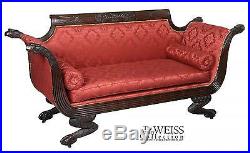

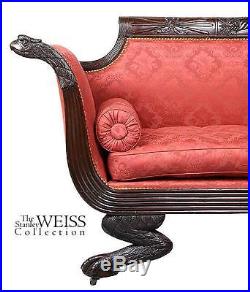
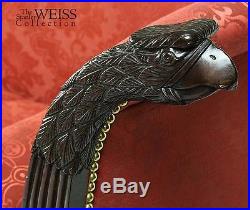
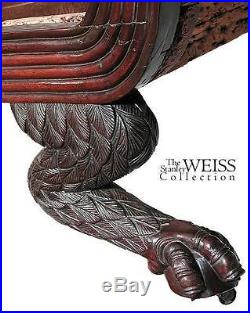

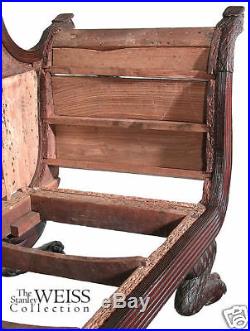


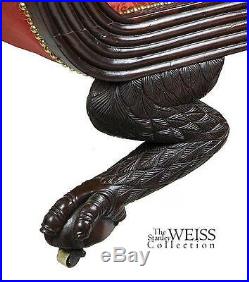
The country’s largest collection of fine Classical & Colonial Furniture… Just steps from the RISD Museum & John Brown House. Tel (401) 272.3200. Tollfree (888) 884.5336. A Classical Carved Mahogany Settee, Providence, RI, c. This is a phenomenal settee with exuberant carving throughout. It appears quite animated with eagle heads at the ends of each arm followed by beautifully developed reeding, all of which is supported by very distinctive carved claw and ball feet. These feet are unusual, because they are not the standard “hairy pawed” foot but a bird’s foot, harkening to earlier Chippendale claw and ball forms, and making a fitting complement for the eagle heads above. A related carved foot can be seen on a similar foot on a sofa on the second floor of the John Brown House in Providence, made by the Rawson family of cabinetmakers. Also, the chestnut is a secondary wood commonly used in Rhode Island furniture. This extraordinarily carved sofa follows the general form of stylish New York sofas of the late 1810s inasmuch as it has a reeded frame in front, stands on animal paw feet, and has a rolled crest carved in three panels. The center panel has opposed cornucopia; the flanking panels have thunderbolts (although only three rather than the customary five); carved ribbons adorn the centers of all three panels. Paired eagle heads at each side terminate the structural elements forming the arms. These unusual carvings recall similar eagle heads on a bedstead by Charles Honoré Lannuier of New York see Peter M. Bretter, and Ulrich Leben, Honoré Lannuier: Cabinetmaker from Paris [New York: Metropolitan Museum of Art, 1998], cat. Rendering of the feathered feet is unlike any other furniture of the 1810s and 1820s. This sofa, which is somewhat later than the Classical Phyfe sofas that were produced c. 1810-20, is a vernacular derivative of New York Classical furniture. However, it goes further with the creative eagle with feet motif than any of the early New York ones did. It is less restrained and more free-flowing in form. The desirable small size of this sofa inevitably raises the question of whether it might have been reduced in length at some point. In its unupholstered state, unequivocal evidence of oxidation and tack holes indicates that the frame has not been altered in any way. It is a pure form, and we have reupholstered it in a fine red fabric, appropriate to the period. An examination and identification report by Philip Zimmerman is available upon request. Height: 36 1/4 in. Seat Height: 13 1/4 in. Length: 76 1/2 in. Seat Depth: 24 in. All offerings are in fine condition with no major repairs or replacements unless otherwise indicated in description. Item must be insured in full. This settee appears quite animated with eagle heads at the ends of each arm followed by beautifully developed reeding, all of which is supported by very distinctive carved claw and ball feet. These feet are unusual, because it’s not the standard “hairy pawed” foot but a bird’s foot, harkening to earlier Chippendale claw and ball forms. The item “SWC-Carved Mahogany Settee, Providence, c. 1820″ is in sale since Friday, July 31, 2009. This item is in the category “Antiques\Furniture\Sofas & Chaises\1800-1899″. The seller is “stanleyweiss” and is located in Providence, Rhode Island. This item can be shipped to United States.
- Type: Sofas & Chaises
- Region of Origin: America
- Age: 1800-1899
- Original/Reproduction: Original
Comments are closed.